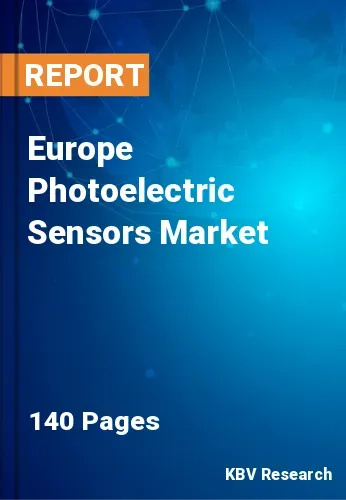The Europe Photoelectric Sensors Market would witness market growth of 5.8% CAGR during the forecast period (2023-2030). In the year 2020, the Europe market's volume surged to 5,559.2 thousand units, showcasing a growth of 5.9% (2019-2022).
Photoelectric sensors are increasingly utilized in healthcare and biotechnology for tasks like liquid level detection in medical equipment, monitoring fluid flow in laboratory instruments, and ensuring precision in diagnostic devices. In retail and logistics, these sensors are deployed for inventory management, object counting, and packaging verification. These sensors contribute to the optimization of supply chain processes by providing accurate and real-time data. Integrating photoelectric sensors with the Internet of Things (IoT) and Industry 4.0 is a prominent trend. This integration allows for real-time data exchange, remote monitoring, and predictive maintenance, enhancing overall operational efficiency.
The food and beverage sector emphasizes various parameters, encompassing product quality control, traceability and tracing, and safety assurance during packaging processes. Consequently, there is a heightened need for sensors to oversee containers positioned on conveyor belts, precisely determine the location of loaded carts, and guarantee the upkeep of sanitary environments. Productivity has increased due to the food and beverage industry's rising demand for packaging solutions, which has contributed to an increase in the demand for intelligent sensors in manufacturing facilities. The food and beverage industry employs sensors for various purposes, including detecting transport crates on conveyor belts, determining the location of loading trolleys, monitoring the level of food items in storage containers, and ensuring accurate measurement of sliced blocks. For example, the food and beverage sector use photoelectric sensors manufactured by SICK AG (Germany) and Omron Corporation (Japan) to regulate machine processes and guarantee increased output.
According to the International Trade Administration, Germany has Europe's third-largest aerospace & defense industry, with 2020 revenues at USD 35.4 billion, following the UK at GBP 79 or USD 90.2 billion (including land defense systems) and France at EUR 50.9 billion or USD 58.1 billion. Some three-quarters or USD 26.2 billion of German production is exported. France received a fourth of these exports with USD 6.7 billion. These sensors are utilized in aircraft guidance and navigation systems. These sensors play a critical role in determining the aircraft's position, altitude, and orientation, contributing to precision navigation and safe flight operations. Therefore, the factors mentioned above will propel market growth in this region.
The Germany market dominated the Europe Photoelectric Sensors Market by Country in 2022 and would continue to be a dominant market till 2030; thereby, achieving a market value of $148.2 Million by 2030. The UK market is showcasing a CAGR of 4.8% during (2023 - 2030). Additionally, The France market would register a CAGR of 6.6% during (2023 - 2030).
Based on Technology, the market is segmented into Retro-reflective, Diffused, and Thru-beam. Based on Application, the market is segmented into Automotive, Electronics & Semiconductor, Packaging, Military & Aerospace, and Others. Based on countries, the market is segmented into Germany, UK, France, Russia, Spain, Italy, and Rest of Europe.
Free Valuable Insights: The Global Photoelectric Sensors Market will Hit $2.8 Billion by 2030, at a CAGR of 6.3%
The market research report covers the analysis of key stake holders of the market. Key companies profiled in the report include Omron Corporation, Panasonic Corporation, Rockwell Automation, Inc., Eaton Corporation Plc., Keyence Corporation, Schneider Electric SE, Autonics Corporation, SICK AG, Balluff GmbH, and IFM Electronic GmbH.
By Technology (Volume, Thousand Units, USD Billion, 2019-2030)
By Application (Volume, Thousand Units, USD Billion, 2019-2030)
By Country (Volume, Thousand Units, USD Billion, 2019-2030)

Our team of dedicated experts can provide you with attractive expansion opportunities for your business.

